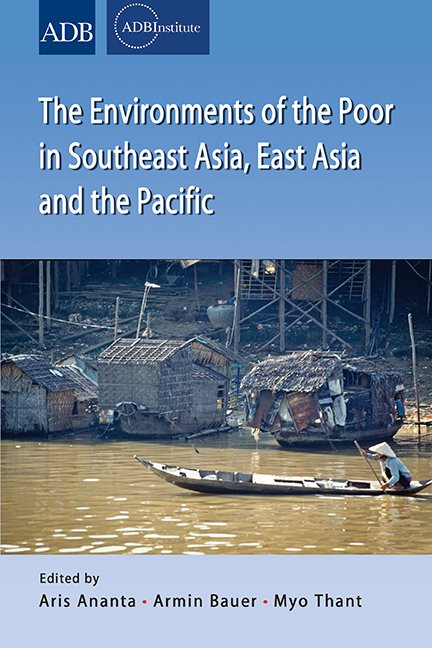Book contents
- Frontmatter
- Contents
- Preface
- List of Contributors
- Part I OVERVIEW
- Part II EAST ASIA (People's Republic of China and Republic of Korea)
- Part III PACIFIC ISLANDS
- Part IV MAINLAND SOUTHEAST ASIA (Cambodia, Thailand, Vietnam)
- Part V ARCHIPELAGIC SOUTHEAST ASIA (Indonesia, Malaysia, Philippines)
- 13 The Political Economy of Environmental Policy in Indonesia
- 14 Prospering in Environmental Degradation: An Illustration from an Upland Area, South Kalimantan, Indonesia
- 15 Making a Living in the Face of Environmental Change: A Case in an Indigenous Community in Sarawak, Malaysia
- 16 The Response of Rural Coastal Households to Typhoon Milenyo in the Philippines
- 17 Life Along Manila's Flooding Rivers
- 18 Quantifying the Health Risks from Pathogens in the Flood Water in Metro Manila
18 - Quantifying the Health Risks from Pathogens in the Flood Water in Metro Manila
from Part V - ARCHIPELAGIC SOUTHEAST ASIA (Indonesia, Malaysia, Philippines)
Published online by Cambridge University Press: 21 October 2015
- Frontmatter
- Contents
- Preface
- List of Contributors
- Part I OVERVIEW
- Part II EAST ASIA (People's Republic of China and Republic of Korea)
- Part III PACIFIC ISLANDS
- Part IV MAINLAND SOUTHEAST ASIA (Cambodia, Thailand, Vietnam)
- Part V ARCHIPELAGIC SOUTHEAST ASIA (Indonesia, Malaysia, Philippines)
- 13 The Political Economy of Environmental Policy in Indonesia
- 14 Prospering in Environmental Degradation: An Illustration from an Upland Area, South Kalimantan, Indonesia
- 15 Making a Living in the Face of Environmental Change: A Case in an Indigenous Community in Sarawak, Malaysia
- 16 The Response of Rural Coastal Households to Typhoon Milenyo in the Philippines
- 17 Life Along Manila's Flooding Rivers
- 18 Quantifying the Health Risks from Pathogens in the Flood Water in Metro Manila
Summary
Waterborne diseases are caused by pathogenic micro-organisms that are directly transmitted when contaminated water is consumed or contacted. As a result of swimming in contaminated water, people often contract acute, but relatively benign, gastroenteritis with a short incubation period and duration (Cabelli 1982). In the flood season, there is a higher risk of infection due to more frequent direct contact with severely polluted water over a longer period. Infectious disease is a major health problem in many flood-prone areas, especially where infectious disease is already endemic (Few 2004). Infectious disease outbreaks of varying magnitude and rates of mortality have been reported following major floods in developing countries. There is some evidence from India and Bangladesh that diarrhoeal disease increases after flooding.
In this essay, we aim to characterize and quantify the human health risks associated with varying levels of exposure to pathogens present in flood water. In our analysis, exposure scenarios according to inundation levels are developed in which direct and indirect contact with polluted water is assumed to occur. We estimated the probabilities of gastrointestinal infection based on established dose- response relationships for the key pathogen present in the flood water (E. coli) (Haas 1989) (See Appendix for dose-relationship details.) The more water one swallows, the more one is exposed to the pathogens, and so the more likely one is to get sick. Since there are no studies estimating the amount of water swallowed by people in flood zones, we adopted the United States Environmental Protection Authority's estimates of the exposure levels of different age groups while swimming or wading. We also assumed that residents are not able to leave the area during floods. As these assumptions are untested, our results may be over- or underestimated.
STUDY SITE
Metro Manila (population 11 million) is the social, economic, and political centre of the Philippines. See Figure 18.1. It is also at the heart of the tropical monsoon climatic zone. Frequent flooding associated with typhoons and other climatic factors is a perennial problem, intensified by the city's being located at sea-level.
- Type
- Chapter
- Information
- Publisher: ISEAS–Yusof Ishak InstitutePrint publication year: 2013



